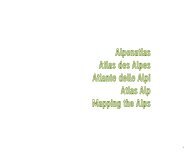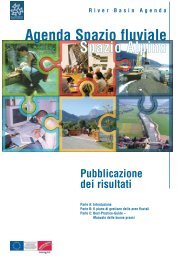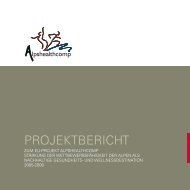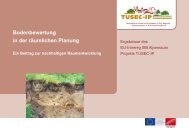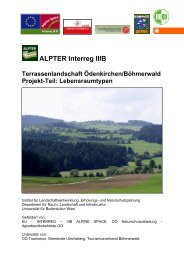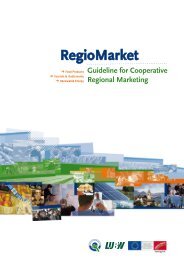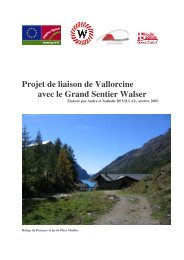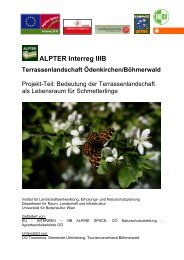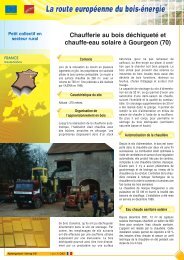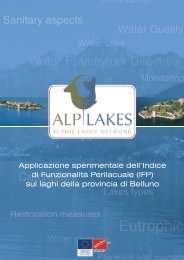1.2 - INTERREG IIIB Alpine Space Programme
1.2 - INTERREG IIIB Alpine Space Programme
1.2 - INTERREG IIIB Alpine Space Programme
You also want an ePaper? Increase the reach of your titles
YUMPU automatically turns print PDFs into web optimized ePapers that Google loves.
68 3.3 ALPS-GPSQUAKENET<br />
environment and cultural heritage<br />
Lead partner<br />
Università degli Studi di<br />
Trieste<br />
Other partners<br />
ARPA Piemonte<br />
ARPA Veneto<br />
BEK- BADW<br />
DGFI- BADW<br />
Provincia A. di Bolzano<br />
Provincia A. di Trento<br />
Univ. Joseph Fourier<br />
Regione Lombardia<br />
Regione Liguria<br />
ARSO<br />
Fond. Montagna Sicura<br />
EOST-IPGS<br />
Project website<br />
www.alps-gps.units.it<br />
Contact person<br />
Karim Aoudia<br />
Tel +39 040 5582128<br />
Fax +39 040 5582111<br />
aoudia@dst.units.it<br />
Duration<br />
0<strong>1.2</strong>004 – 12.2006<br />
Total budget in EUR<br />
2.424.638<br />
ERDF in EUR<br />
<strong>1.2</strong>10.119<br />
Lead partner<br />
Project partner<br />
I<br />
I<br />
I<br />
D<br />
D<br />
I<br />
I<br />
F<br />
I<br />
I<br />
SI<br />
I<br />
F<br />
<strong>Alpine</strong> Integrated GPS Network: Real-Time Monitoring and Master Model<br />
for Continental Deformation and Earthquake Hazard<br />
The aim of the ALPS-GPSQUAKENET is to build up a high-performance transnational space geodetic<br />
network of Global Positioning System (GPS) receivers in the Alps.<br />
Aim<br />
The use of modern space based techniques gives us new potential<br />
to monitor and prevent natural risk, reduce economic<br />
losses, and save lives.<br />
The project is developed considering the lack of a transnational<br />
and high-performance space geodetic network of Global<br />
Positioning System (GPS) receivers in the <strong>Alpine</strong> <strong>Space</strong>. The<br />
project GPS array, within the millimeter-per-year precision,<br />
will represent the first ever installed transnational space geodetic<br />
network in the Alps. This will support the use of space<br />
based techniques that will provide the experimental basis of<br />
our scientific understanding of natural hazards in general and<br />
earthquakes in particular.<br />
Activities<br />
The project is successful due to its partnership that is represented<br />
by research institutions with powerful internationally<br />
recognised education and outreach programs, national and<br />
governmental agencies and regional public departments. The<br />
project strategy stands in the transnational structure of the<br />
partnership comprising both the geoscientists and end-users,<br />
providing an excellent means for the cross-training and interaction<br />
of regional employees and young scientists. The GPS<br />
array will satisfy the performance required by all the GPS applications<br />
and allow their implementations. The project covers<br />
different facets contributing to the reduction of natural hazards<br />
such as: crustal deformation for earthquake potential, meteorology,<br />
landslide monitoring, agriculture, navigation, transportation,<br />
mapping and surveying.<br />
Outcomes and results<br />
The results reached so far are:<br />
75% of the GAIN GPS array is operative<br />
Project data centre and web site fully working<br />
Earth model, for the whole Alps, of the first 350 km depth<br />
structure<br />
Model of lithospheric flow and stress pattern<br />
Earthquake moment tensors inversion for relevant earth-<br />
quakes in the Alps and surroundings<br />
Velocity field of: The French permanent GPS network in the<br />
Alps (REGAL), the Jura mountain and the junction between<br />
South-Eastern Alps and external Dinarides<br />
Monitoring of tropospheric humidity by GPS in south-eastern<br />
France<br />
Active fault monitoring: Rhone Alps, Friuli and western Slovenia<br />
Landslides monitoring using GPS: Piemonte and Trentino<br />
Foreseen:<br />
Full GAIN GPS array and processing of the data<br />
Possibly parts of the EUREF network have to be re-processed<br />
to gain first information before the end of the project<br />
Maps of the strain rate, displacements and distribution of the<br />
stress field at depth throughout the study area due to active<br />
tectonics and post-glacial rebound<br />
Visco-elastic + state and rate friction modelling of the stress<br />
evolution<br />
Earthquake hazard calculations for the whole Alps



